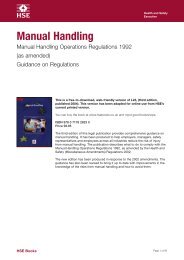Making Companies Safe - what works? (CCA ... - Unite the Union
Making Companies Safe - what works? (CCA ... - Unite the Union
Making Companies Safe - what works? (CCA ... - Unite the Union
Create successful ePaper yourself
Turn your PDF publications into a flip-book with our unique Google optimized e-Paper software.
Similarly, firms might make an economic calculation that lost-time injuries cost more<br />
(in productivity terms) than occupational diseases characterised by long latency periods<br />
and difficulty in proving that <strong>the</strong> condition was caused by work (such as lung cancer). In<br />
economic terms, it would be perfectly rational for employers to reduce expenditure aimed at<br />
minimising workers’ exposure to carcinogens, even where this resulted in a significant risk to<br />
workers, and spend that money instead on reducing slips, trips and falls. Not only, <strong>the</strong>refore,<br />
might employers fail to safeguard workers in relation to <strong>the</strong> full range of health and safety<br />
hazards, but <strong>the</strong>y might also prioritise less serious hazards over life-threatening diseases<br />
simply because <strong>the</strong> less serious hazards cost <strong>the</strong> firm more.<br />
An example from <strong>the</strong> empirical literature is <strong>the</strong> case of <strong>the</strong> Esso Gas Plant explosion, which<br />
occurred outside Melbourne. Evidence suggests that management were conflicted between<br />
<strong>the</strong> need to control potential major hazards arising from business operations at <strong>the</strong> Longford<br />
plant, and <strong>the</strong> need to reduce <strong>the</strong> costs of lost time injuries. They chose to focus on <strong>the</strong><br />
latter at <strong>the</strong> expense of <strong>the</strong> former, with disastrous results. 19<br />
There are <strong>the</strong>n potential dangers to workers in advocating an approach based on economic<br />
calculation, since <strong>the</strong> logical extension of <strong>the</strong> HSE’s argument is that “<strong>the</strong> rational employer<br />
should… prioritise <strong>the</strong> avoidance of accidents by reference to potential financial returns” 20<br />
ra<strong>the</strong>r than by reference to <strong>the</strong> relative risks to workers health and safety posed by a range of<br />
existing hazards.<br />
Reputational Risk<br />
Whilst government agencies have not been particularly successful in persuading companies<br />
of <strong>the</strong> economic benefits of improved Occupational Health and <strong>Safe</strong>ty performance, it is now<br />
being suggested that regulators should concentrate on persuading employers that safety pays<br />
in terms of o<strong>the</strong>r (sometimes non-tangible) business benefits, which never<strong>the</strong>less ultimately<br />
affect <strong>the</strong> bottom line. 21 There is some support for <strong>the</strong> contention that reputational risk<br />
motivates employers to comply with <strong>the</strong> law. 22 For instance, an OECD report found that:<br />
“many enterprises are motivated to comply with <strong>the</strong> law, or at least to appear to<br />
comply with <strong>the</strong> law, in order to maintain <strong>the</strong>ir legitimacy in <strong>the</strong> eyes of <strong>the</strong><br />
government, industry peers, and <strong>the</strong> public… Hoffman’s (1997) study of<br />
corporate environmentalism in <strong>the</strong> US petroleum and chemicals industry uses<br />
neo-institutional <strong>the</strong>ory to explain why <strong>the</strong> growth in corporate attention to<br />
environmental issues did not follow trends in volume of new environmental laws<br />
and regulations nor growth in industrial expenditure on environmental issues as<br />
deterrence <strong>the</strong>ory would predict, but ra<strong>the</strong>r rose and declined with public<br />
concern with environmentalism… Similarly Rees’ (1997) study of <strong>the</strong> emergence<br />
of <strong>the</strong> US Chemical Manufacturers’ Association, Responsible Care, self-regulatory<br />
programme also finds that it was <strong>the</strong> imperatives of institutional legitimacy that<br />
forced chemical companies to regulate <strong>the</strong>mselves after <strong>the</strong> Bhopal accident,<br />
ra<strong>the</strong>r than a simple model of deterrence.” 23<br />
However, <strong>the</strong>re are two problems with a straightforward acceptance that ‘repuational risk’ is<br />
a significant motivator of firm behaviour. First, as <strong>the</strong> OECD report acknowledges:<br />
“a number of scholars who have researched in this area have pointed out<br />
that often a concern with legitimacy can motivate enterprises to manage <strong>the</strong>ir<br />
image of compliance, without necessarily complying substantively with <strong>the</strong><br />
requirements of regulation”. 24<br />
72<br />
Second, much of <strong>the</strong> evidence concerning <strong>the</strong> effects of public opinion come from<br />
studies concerned with industry initiatives in relation to environmental management whereas<br />
evidence on <strong>the</strong> extent to which reputational factors influence health and safety management<br />
have been mixed. For instance, an evaluation of <strong>the</strong> ‘Good Health is Good Business’ campaign<br />
found that only 2% of respondents (including both large organisations and SMEs) made<br />
improvements mainly due to <strong>the</strong> wish to improve company image and reputation. And only<br />
1% of respondents cited shareholder, bank, or public pressure as <strong>the</strong> main reason for making<br />
improvements. 25
















